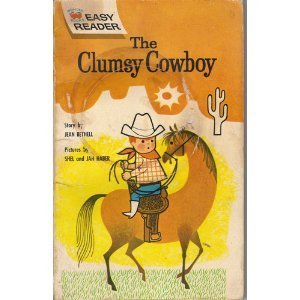The Clumsy Cowboy
/ When I was a little kid I had a little book called The Clumsy Cowboy that I treasured. It was about a cowboy who couldn’t stay on his horse. After going through some trials and tribulations he eventually solves the problem by attaching himself to the saddle with a bucket of glue. No doubt, before the invention of stir-ups in the 3rd century a lot of cowboys had this problem. But even after that one can imagine that wielding a weapon from horseback ran the risk that when the weapon came into contact with a fearsome warrior the sudden shock would transfer to the rider causing him to either drop the weapon or fall off his horse.
When I was a little kid I had a little book called The Clumsy Cowboy that I treasured. It was about a cowboy who couldn’t stay on his horse. After going through some trials and tribulations he eventually solves the problem by attaching himself to the saddle with a bucket of glue. No doubt, before the invention of stir-ups in the 3rd century a lot of cowboys had this problem. But even after that one can imagine that wielding a weapon from horseback ran the risk that when the weapon came into contact with a fearsome warrior the sudden shock would transfer to the rider causing him to either drop the weapon or fall off his horse.
Of course, whether or not one falls off their horse also depend on what sort of weapon they are using and how they are using it. But any force transferring into the rider’s body is going to either hurt or knock him off the horse. If the force transfers to the rider’s wrists he will probably drop the weapon. The goal in such collisions of force is for the rider to transfer all the shock directly to the horse. The horse can handle it.
This is clearly one of the origins of horse stance. Shaolin and Tai Chi are almost identical in the way they use horse stance. When we punch from horse stance it is essential that whatever resistance we meet is transfered to the imaginary horse-- the imaginary horse between our legs that is. Really this imaginary horse is the lower part of the dantian and at the physical level requires that we relax and expand our base, especially the underside of the thighs, to redistribute all incoming force. This can only be learned by having a teacher who understands how it works resist your punches while giving direct feedback about the quality of the punch. Although the mechanism should be the same in Shaolin and Tai Chi, meaning it could be classified as either internal or external depending I guess on how well one does it, most people who learn to punch from horse stance only learn to generate power.
Horse stance is not a particularly good stance for punching, in fact, it is a bit ridiculous. To get power from a horse stance most people lean and push through their feet, which is of course wrong. The whole reason for using horse stance to train punches is so that the student can learn to hit while staying perfectly upright and simultaneously transfer all the incoming force to the horse. It’s a difficult stance, if the student can accomplish this task in horse stance then that skill will transfer easily to any other stance.
